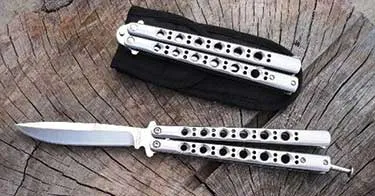Balisong, the famed Batangas Butterfly Knife, May Not Have Been Invented in Batangas
Like many young boys my generation, this writer used to own a balisong back in the seventies when he was in high school. Not that he ever intended to use it. It was just one of those things one kept for a just-in-case moment, not to mention owning one brought with it some level of prestige. Besides, because all other ethnicities in this country thought all Batangueños carried a balisong, it felt almost obligatory to reinforce the stereotype and own one.
Because this writer was on a tight high school budget, his balisong was not the expensive sort at all. Still, it was crafted in the town of Taal in Batangas, famous for the balisong at the time as it was for barong Tagalog. It had a beautifully carved horn handle, from whence, it is generally believed, the name balisong – “baling sungay” or broken horn – was coined.
Because the balisong is known worldwide, its name has even been included in some dictionaries of the English language. The Advanced English Dictionary defines the balisong as “a folding pocket knife with two handles counter-rotating around the tang such that, when closed, the blade is concealed within grooves in the handles.1”
Alternatively, the balisong is also known worldwide as the butterfly or fan knife after the way its two handles open from being a compact tool with the blade hidden. It is also sometimes called the Batangas knife2, likely because its manufacture is an industry in the province but most particularly in Taal, where there is even a village called Balisong.
What this author and friends, as teenagers, took as fact was that the balisong was a Batangueño invention, despite its apparent worldwide fame. It was not uncommon, for instance, to see such a knife used in a Hollywood gangster movie. However, this writer is belatedly discovering that the balisong may not even be a Batangueño invention at all.
 |
| Image credit: By Iamthawalrus - Own work, CC BY-SA 3.0, https://commons.wikimedia.org/w/index.php?curid=30337122. |
The Philippine-origin theory about the balisong stems from the belief, probably of martial arts practitioners, that the knife was used in the Filipino martial art called “Kali,” the origin of which is dated all the way back to 800 A.D. There is no hard evidence, however, to support this belief.3
Audra Draper of the web site “The Balisong Collector’s Page,” however, has an alternative theory; and this one is backed by historical documentation. Draper cites a French book published in 1710 called “Le Perret,” which includes a sketch of the design of the balisong. A copy of the book is available at the Museum of Thiers in France.
In the same article, Draper also presented a copy of a patent issued in England to a German cutlery firm called Bontgen and Sabin’s. The description of the gadget being patented is unmistakably that of a balisong: “The handle consists of two shells, which are pivoted to the blade and completely enclose it when shut, being held together by a clasp. When open, the two parts are also held by the clasp, and the recesses fit on either side of the pin on the blade.4”
If, indeed, the balisong was invented in France, then it was a matter of time before its use spread to European neighbors Germany, England and Spain. It is entirely plausible that a balisong might have crossed the oceans to the Philippines brought along by a Spaniard, and the timeframe of the “Le Perret” certainly coincided with the Spanish colonial era in the Philippines.
An article on the web site “Pinoy Steel” says that there are even those who believe that it was Jose Rizal himself, returning from his European sojourn, who brought with him a European butterfly knife to the country. However, the article also conjectures that, conversely, Rizal could have introduced the balisong to Europe.5
It is probably doubtful that he did. Most sources credit a Taaleño craftsman by the name of Perfecto de Leon with the manufacture of the first Filipino Balisong in 1905, nine years after Rizal was put to death by firing squad at the Bagumbayan field. The accuracy of the year, however, is placed in doubt by author Mark V. Wiley, who wrote that de Leon manufactured his first balisong in the forties.6
Whatever the year, a direct consequence of de Leon’s manufacture of the first Filipino balisong is the spawning and growth of the balisong manufacturing industry in the village that will eventually be named after the knife. Even in the present day, the roads of the village are lined with stalls and shops selling balisongs of countless designs.
The subsequent growth in popularity of the balisong worldwide, and particularly so in the United States, was down to soldiers of the United States Sixth and Eighth Armies who participated in operations to liberate Batangas from Japanese rule in the forties as well as post-war reparation efforts afterwards. Many of these soldiers, upon their return to the United States after the war, brought home with them balisongs probably as souvenirs.
Although the debate continues about where the first butterfly knife was actually created, that it matters is probably less significant. After all, the word balisong has found its way into English dictionaries and is frequently described in worldwide web sites as a Filipino knife manufactured in Batangas. Hardly anyone, if at all, calls it a European knife.
2 “Butterfly Knife,” Wikipedia.
3 “Balisong History,” online at Balisong, Balls and Bandages.
4 “The History of the Balisong,” by Audra Draper, MS, online at “The Balisong Collector’s Page.”
5 “Balisong History,” online at Pinoy Steel.
6 “Arnis: Reflections on the History and Development of Filipino Martial Arts,” by Mark V. Wiley, 2001.
